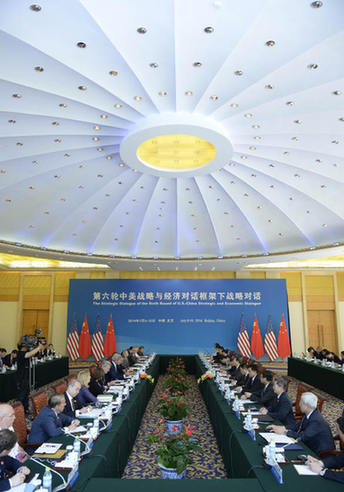Mutual Trust Tried and Tested
Two important high-level discussions between Chinese and U.S. policymakers concluded on July 10 in Beijing. The sixth China-U.S. Strategic and Economic Dialogue and the fifth China-U.S. High-Level Consultation on People-to-People Exchanges ended successfully, according to participants from both sides. The latest rounds of dialogue, which featured candid exchanges of views and differences, will help build a new type of major-power relationship between China and the United States.
|
 |
|
The sixth round of China-U.S. Strategic and Economic Dialogue was held in Beijing from July 9 to 10. |
Mutual distrust, the cause of all the ups and downs in Sino-U.S. relations, manifests when the two countries misjudge one another’s strategic intent. President Xi Jinping got right to the point, saying that the way China and the U.S. perceive each other’s strategic intentions directly influences their policies and the development of bilateral ties. Therefore, he urged, the two sides should not err on this fundamental issue.
Mutual trust, however, does not grow overnight. It demands consistent efforts from both sides, particularly through strategic reassurance, to reduce misunderstandings and suspicion.
The annual dialogue and consultation have yielded positive results in the form of extensive agreements over a wide range of regional and global issues. One breakthrough is the formulation of a timetable for the Bilateral Investment Treaty (BIT) talks, both sides having agreed to resolve core issues and finalize the major provisions of the BIT by the end of the year. Talks on the “negative list,” which prohibits some cross-Pacific investments, have been scheduled for early 2015.
The agreement to expedite the BIT talks to reach an early resolution is of great importance to the development of economic trade ties and for increasing interdependence between the two economies.
Another major breakthrough is the agreement to develop bilateral military ties. The two countries will continue to hold joint exercises on counterpiracy, maritime rescue, and disaster reduction. They have also agreed to establish a notification mechanism for major military activities, which will greatly improve relations between the two militaries.
Military ties gained prominence in Sino-U.S. relations since the Sunnylands meeting between President Xi Jinping and his U.S. counterpart Barack Obama in June last year, followed by frequent exchange of high-level visits between senior military officials and joint military exercises. China’s participation in the U.S.-led Rim of the Pacific multinational naval exercise for the first time signifies an unprecedented thaw in military-to-military relations.
